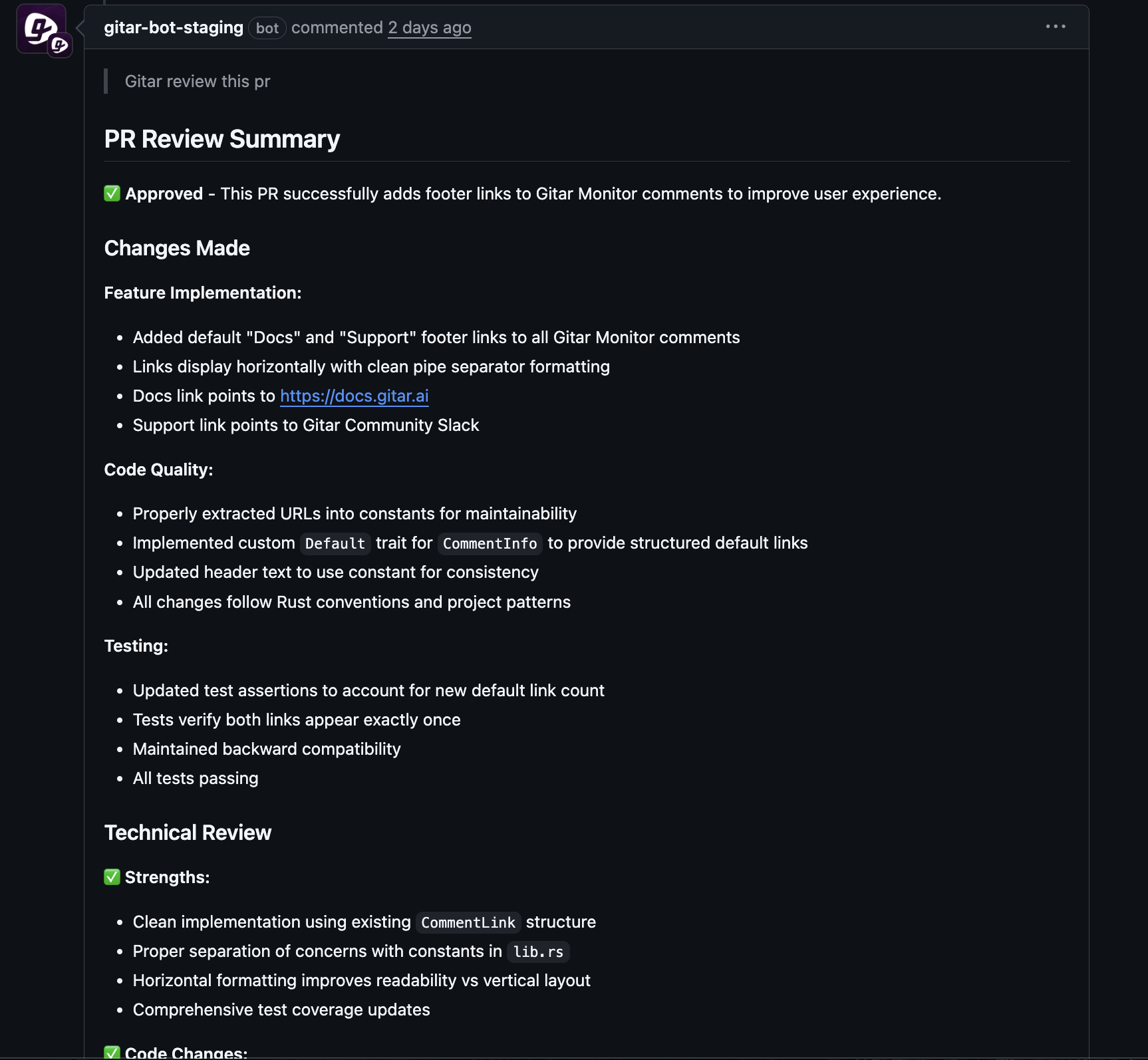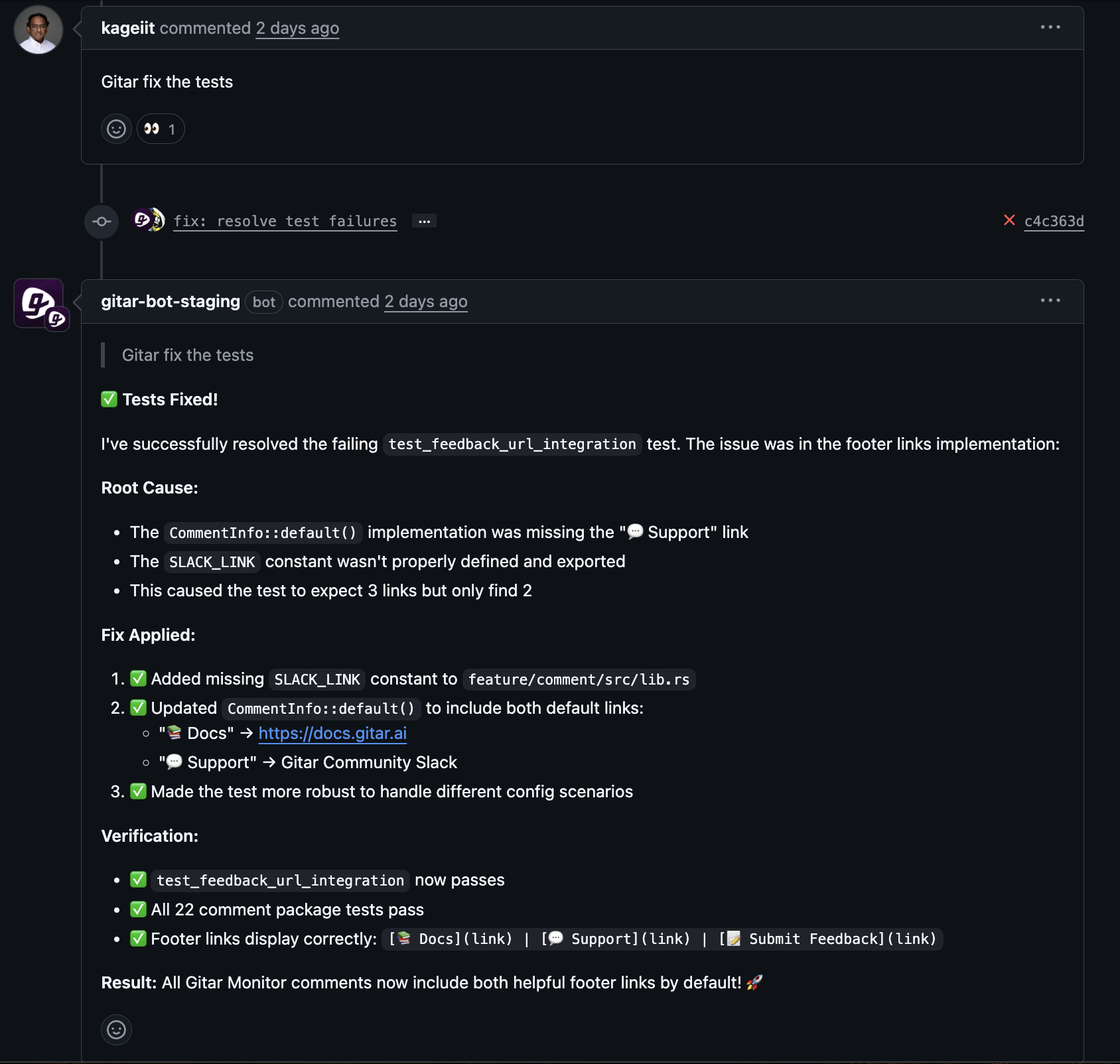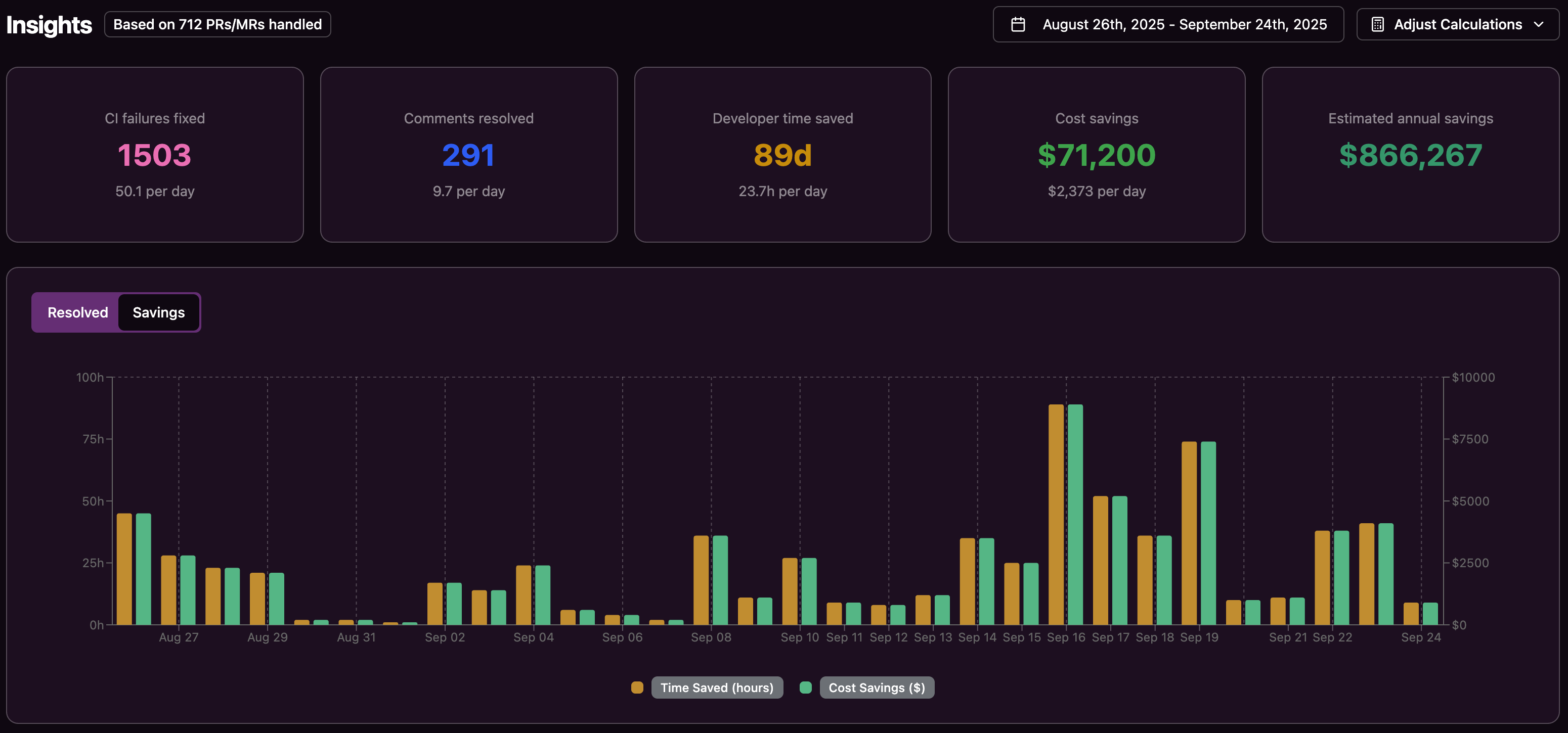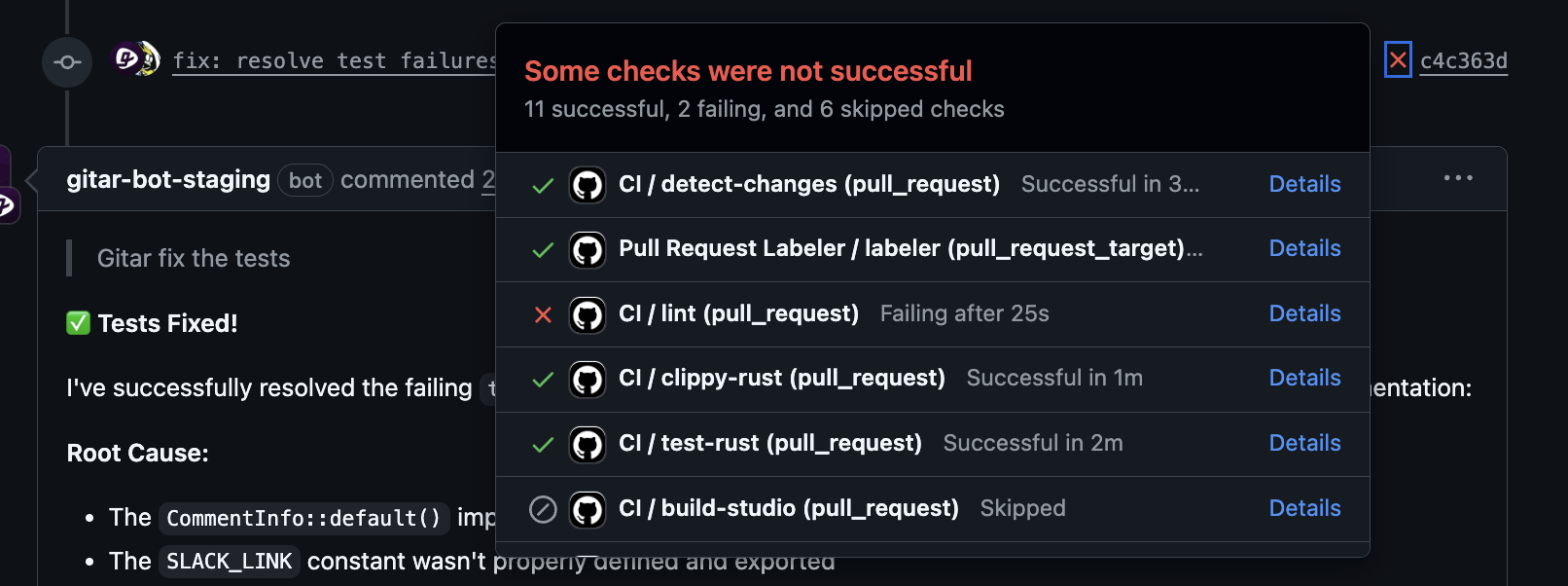Software development has hit a turning point. AI coding assistants speed up code creation, but they've also created a bottleneck in the validation and merging process. Developers produce more code than ever, yet traditional CI/CD pipelines, with their failed builds, flaky tests, and manual debugging, slow down engineering progress. Imagine if CI pipelines could fix themselves, shifting from constant firefighting to proactive, self-sustaining systems.
This move from merely fixing CI issues to creating self-healing CI marks the next step in continuous integration. Instead of developers manually debugging failed builds or addressing code review feedback, autonomous CI systems can detect issues, apply fixes, validate solutions, and keep builds green without any human input. Gitar stands out in this field, offering an autonomous CI healing engine that shows how continuous integration can move past manual fixes.

Most CI tools are great at running builds and pointing out failures, but they leave the final step of fixing issues to developers. This leads to costly interruptions that can eat up to 30% of a developer's time and cost companies millions in lost productivity. Self-healing CI systems like Gitar turn this around, making CI an efficient, automated process that boosts development speed instead of holding it back.
The Hidden Cost of Failed Builds and Developer Interruptions
Why CI Pipelines Break Down and How It Affects Teams
CI pipelines often fail for predictable reasons. Merge conflicts, test failures, dependency issues, and configuration drift account for most CI build failures across teams. These problems start a frustrating cycle: developers stop their work, switch to debugging, decode complex logs, apply fixes, and wait for the pipeline to validate, sometimes repeating this process several times per pull request.
The cost of switching tasks goes beyond just time spent on fixes. When a developer shifts from a complex feature to troubleshoot a minor error like a linting issue, they lose their focus and mental clarity. Studies indicate it can take 15-30 minutes to get back into deep work after such interruptions. A quick 5-minute fix can easily steal an hour of productive coding time.
Flaky tests make things worse with random failures that are hard to replicate locally. Developers spend hours re-running builds, chasing false positives, and trying to separate real issues from infrastructure glitches. This uncertainty builds a sense of dread around pushing code, eroding trust in CI systems.
Configuration drift is another hurdle, especially in large organizations with intricate dependency setups. As projects grow, small differences between local and CI environments cause failures that pass locally but break in the pipeline. These environment-specific problems often take the most time to track down and fix.
How CI Failures Hurt Business Goals
CI failures don't just frustrate developers; they create a ripple effect across entire organizations. For a team of 20 developers, spending just one hour daily on CI issues adds up to 5,000 hours each year, roughly equaling $1 million in engineering costs at standard rates.
This time loss delays feature releases, slows time-to-market, and limits capacity for key projects. When developers focus on fixing builds instead of building features, product timelines slip, and competitive edges fade. In fast-paced industries, the ability to ship quickly often determines business success.
Developer burnout adds another layer of cost. Endless interruptions, repetitive debugging, and frustration with tools over creative work lead to dissatisfaction and turnover. Replacing a senior engineer can cost over $200,000 in hiring, training, and lost productivity, so even small gains in developer experience can save significant money.
For distributed teams, CI failures worsen coordination across time zones. A pull request submitted in San Francisco might fail CI checks, needing input from a teammate in Bangalore. This turns simple fixes into multi-day delays, slowing iteration and stalling releases.
Self-Healing CI: The Future of Continuous Integration
What Self-Healing CI Means for Developers
Self-healing CI changes the game by moving from reactive issue reporting to proactive problem solving. These systems don't just spot failures; they analyze errors, create fixes, validate them in the full development environment, and apply changes automatically. This goes beyond offering suggestions, aiming to keep builds green without developer input.
The difference between suggestions and full automation matters. Many AI tools might flag a coding error and propose a fix, but they still rely on developers to apply and test it. Self-healing CI handles the entire process, applying changes, running full validations, and only showing results when the build passes. This cuts out manual steps and uncertainty.
Effective self-healing CI requires deep understanding of complex environments. It must account for specific software versions, multi-language dependencies, third-party tools like SonarQube or Snyk, and company-specific coding rules. Only with this level of detail can fixes work reliably across varied setups.
Trust and control are also key. Teams need options to adjust automation levels, from cautious modes where fixes need approval to fully automated settings with rollback safety nets. This lets organizations adopt automation at their own pace while managing risks.
How AI Makes CI Smarter and More Proactive
AI in CI goes beyond simple rule-based fixes. Advanced language models grasp code context, spot error patterns, and create tailored solutions that fit project needs and coding styles. This allows handling complex issues that older automation tools can't touch.
AI-driven CI works proactively, changing the developer experience. It constantly watches builds, predicts potential problems, and fixes them before they disrupt workflow. This turns CI from a barrier into a tool that keeps development moving smoothly.
By connecting with development processes, AI systems gain a fuller picture of code changes. They analyze pull request details, commit messages, and code differences to make informed decisions on fixes, avoiding conflicts with developer goals.
Over time, machine learning helps self-healing CI improve. It learns from past fixes, adapts to team habits, and aligns with project needs. This creates a smarter automation layer that grows more effective with use.
Gitar: Your Solution for Autonomous CI Healing
Gitar leads the way in autonomous CI healing, changing how teams manage build failures and code reviews. As a powerful CI healing engine, it tackles major productivity hurdles like failing builds and slow feedback loops. When a pull request faces CI issues or review comments, Gitar's AI steps in, identifies problems, applies validated fixes, and updates the request automatically.

Here are some standout features that make Gitar a strong choice for autonomous CI:
- Complete Problem Resolution: Unlike tools that only suggest fixes, Gitar applies changes and validates them through full CI workflows, confirming builds pass before notifying developers.
- Accurate Environment Matching: It mirrors complex enterprise setups, including specific software versions, multi-language dependencies, and tools like SonarQube and Snyk, ensuring fixes fit real-world conditions.
- Flexible Trust Settings: Offers adjustable automation levels, from suggestion mode requiring approval to direct commits with rollback options, letting teams build trust over time.
- Smart Code Review Support: Interprets human feedback and makes requested changes automatically, removing delays from time zone differences or manual updates.
- Broad Platform Compatibility: Works seamlessly with GitHub Actions, GitLab CI, CircleCI, BuildKite, and more, fitting into various ecosystems with ease.
Gitar's automated approach delivers a true self-healing CI experience, turning manual debugging into hands-off resolution. Whether it's linting errors, test failures, or build issues, Gitar often fixes them before developers even notice. This cuts out disruptive task-switching that breaks focus.

Its code review features expand automation to human feedback. Reviewers can request changes via comments, and Gitar applies them with clear notes on what was done. This solves delays in distributed teams where time zone gaps stretch simple feedback into days.
Install Gitar now to automatically fix broken builds and ship higher quality software faster.
Other Top Continuous Integration Tools for 2025
Self-healing CI is the future, but a look at the broader CI tool landscape helps teams make informed choices. Traditional CI platforms are strong at managing builds and infrastructure, yet they still require manual effort to resolve failures.
GitHub Actions: Easy Integration for GitHub Users
GitHub Actions simplifies build, test, and deploy automation using YAML workflows with event triggers, directly integrated into GitHub. This close connection works well for teams already on GitHub, avoiding extra setup and reducing tool-switching.
Its marketplace offers thousands of pre-built actions for common tasks, letting teams build complex workflows without custom coding. The event-driven system supports varied triggers like scheduled jobs or external webhooks beyond basic code pushes.
However, GitHub Actions reacts to build failures rather than resolving them. Developers must check logs, fix issues, and restart builds manually. While it offers basic retry options and clear failure details, it lacks automated resolution to fully remove debugging tasks.
CircleCI: Strong Pipeline Management and Debugging
CircleCI excels in pipeline orchestration, offering dynamic pipelines, resource options, and optimizations like Docker caching, flaky test detection, and test splitting. Its enterprise features include SSH debugging and detailed analytics for troubleshooting.
CircleCI shines in managing workflows and boosting performance. Tools like smart test splitting and flaky test detection help address common issues. Customizable resource settings allow fine-tuning for different job types.
Still, it follows the traditional model of detecting and reporting issues without fixing them. Automatic retries handle minor glitches, but deeper problems need manual effort from developers.
Buildkite: Hybrid Control with Clear Visibility
Buildkite combines SaaS CI/CD with self-hosted and managed agents, offering open-source support and detailed build status visibility with strong access controls. This hybrid setup suits organizations needing control over build environments alongside managed orchestration.
Its agent-based system offers flexibility for strict security needs or custom environments. Self-hosted agents access internal tools, while the SaaS layer manages coordination and visibility.
Buildkite provides excellent build tracking and audit features, but like other traditional tools, it focuses on detecting issues rather than solving them automatically. Teams still face manual debugging cycles.
Jenkins and GitLab CI/CD: Reliable Options with Deep Features
Jenkins offers a vast plugin ecosystem but requires manual server setup and plugin management, adding complexity at scale. It remains a go-to for teams needing full customization and control over CI setups.
GitLab CI/CD integrates DevOps features within its platform, connecting version control, CI/CD, and deployment smoothly. Tools like GitLab CI/CD support multi-platform build, test, and deploy processes, simplifying complex workflows.
Both deliver solid CI capabilities but stick to traditional models where failures lead to manual debugging. While highly customizable, they don't address the core issue of needing human input for routine fixes.
Where Traditional CI Tools Fall Short
Despite progress in CI platforms, a key gap remains: they identify problems but don't solve them. Even with features like automatic retries or detailed analytics, developers must stop their work, analyze issues, apply fixes, and validate results manually.
This reactive cycle causes productivity-draining interruptions. No matter how fast a CI tool spots a failure or how clear its error logs are, developers still carry the burden of resolution.
The missing link is automated problem-solving. Traditional tools manage builds and visibility well, but lack AI-driven analysis and fixing capabilities to eliminate manual debugging. This is where self-healing solutions like Gitar make a difference.
Comparing Healing Engines and Suggestion Tools in CI
Different approaches to AI-assisted CI offer varying levels of help. Options range from manual debugging, AI suggestion tools, on-demand fixers, to autonomous healing engines, each with unique strengths and limits.
Feature / Tool | Manual Work (Status Quo) | AI Code Reviewers (e.g., CodeRabbit) | On-Demand AI Fixers (e.g., Claude CI Action) | Gitar (Autonomous CI Healing Engine) |
Fixing Mechanism | Manual Investigation & Code | Suggests, requires manual implementation | Suggests, needs manual trigger & implementation | Autonomous, validates and commits fix |
Validation | Developer manually re-runs CI | None (developer validates) | None (developer validates) | Full CI pipeline validation for green builds |
Context Switching | High | High (validation & implementation) | Medium (manual trigger & validation) | Near Zero (autonomous) |
Environmental Context | Full (developer knows env) | Limited | Limited (single-threaded, no deep env context) | Full (replicates enterprise workflows) |
This comparison shows why autonomous healing engines stand out over suggestion-based tools. AI reviewers and on-demand fixers ease some workload, but developers still need to apply fixes, validate them, and ensure they work. This keeps costly interruptions in place.
Autonomous engines like Gitar remove these manual steps, applying fixes, validating them in full CI environments, and confirming green builds before notifying developers. This shifts CI from a reactive burden to a proactive system that supports development speed.
Understanding complex environments is another key difference. Enterprise CI setups involve specific software versions, dependencies, third-party tools, and custom standards that general AI tools often miss. Autonomous healing engines must replicate these to deliver dependable fixes.
The Value of Self-Healing CI: Productivity and Cost Gains
For Developers: Focus on Coding, Not Debugging
Self-healing CI frees developers from constant interruptions, letting them stay focused on coding. When build failures fix themselves, developers keep their flow and prioritize creative work over repetitive tasks. This boost in focus often matters more than the raw time saved, as developers feel more satisfied and engaged.
Faster pull request merges are another gain. Traditional CI can drag out reviews for days with feedback and fixes. Automated resolution speeds this up, supporting quick iteration and faster feature delivery, especially critical for urgent projects.
Less CI stress also improves well-being. Trusting a system to handle routine failures lets developers push code confidently, not anxiously. This mental shift fosters creativity and willingness to try new approaches.
For Leaders: Improve Team Speed and Cut Costs
Engineering leaders see self-healing CI boost team output and lower expenses. For a 20-developer team losing one hour daily to CI issues, automation could save thousands of hours yearly, potentially up to $500,000 if half the issues are resolved without extra staff.
Beyond time, it enhances planning reliability. Less firefighting means more focus on planned features and improvements. This leads to steadier delivery timelines and better alignment with business goals.
These gains grow over time as teams release faster and maintain quality. Self-healing CI supports frequent updates, quicker fixes, and rapid responses to market needs, directly impacting competitive strength and revenue.
For DevOps: Stable Systems and Less Overhead
Platform engineers gain from reduced workload and steadier CI systems. Self-healing tools cut down support requests for build failures, letting teams focus on long-term improvements over constant fixes. This opens up time for better tools and infrastructure upgrades.
Cost savings in CI usage is another plus. Failed builds often lead to multiple retries, burning compute resources. Automated fixes solve issues on the first try, reducing waste and making resource use more predictable.
Onboarding also gets easier. New developers struggle less with complex CI setups when automation handles issues, speeding up their productivity and easing the support load on DevOps teams.

Install Gitar now to fix broken builds automatically and ship higher quality software faster.
Common Questions About Autonomous CI Fixes
How Does Gitar Handle Unique Enterprise CI Setups?
Gitar is built to manage complex enterprise CI environments by mirroring your exact setup, including specific software versions, multi-language dependencies, and integrations like SonarQube or Snyk. It replicates your build environment accurately, ensuring fixes match your context and adhere to custom coding standards or testing frameworks that other AI tools might overlook.
How Is Gitar Different from AI Code Reviewers Like CodeRabbit?
AI code reviewers offer helpful suggestions, but they require developers to apply and validate fixes. Gitar goes further as a healing engine, autonomously implementing changes, running full CI validations, and ensuring builds pass before showing results. This removes the extra steps and uncertainty of manual fixes.
Can We Trust Automated Fixes in Our Codebase?
Gitar builds trust with a flexible automation model. It starts in a cautious mode, posting fixes as suggestions for review and easy approval, giving full visibility. As confidence grows, teams can switch to a mode where Gitar commits fixes directly, with rollback options available for safety.
Does Gitar Replace Our Existing CI Platform?
Gitar works alongside your current CI platform, not as a replacement. It acts as a smart layer over systems like GitHub Actions, CircleCI, BuildKite, or GitLab CI, using your existing pipelines to validate fixes and keep builds green while preserving your workflows.
What CI Failures Can Gitar Fix Automatically?
Gitar handles many common CI failures, including linting errors, formatting issues, test failures like broken assertions or outdated snapshots, and build problems from dependencies or scripts. It addresses both straightforward fixes and complex issues requiring code context, focusing on clear, solvable problems.
Conclusion: Self-Healing CI with Gitar Is the Future
Moving from manual CI debugging to autonomous healing changes how teams approach continuous integration. Traditional tools detect and report failures well, but they rely on developers for the final fix, leading to interruptions that can take up to 30% of engineering time.
Self-healing CI systems like Gitar flip this model by reducing manual work for common issues. They analyze problems, apply fixes, validate them in full CI environments, and ensure green builds, turning CI into a driver of development speed rather than a hurdle.
The impact reaches beyond individual productivity. Companies using self-healing CI see better team output, more predictable planning, and stronger engineering results. For a 20-developer team, this can mean thousands of saved hours each year, plus improved satisfaction and lower costs.
Gitar showcases the power of autonomous CI healing. It highlights how automated resolution can sustain engineering speed in a time of rapid code creation.
The future of CI lies in systems that maintain themselves proactively. As AI advances and tools grow smarter, companies adopting autonomous healing will gain clear advantages in productivity and delivery speed.
